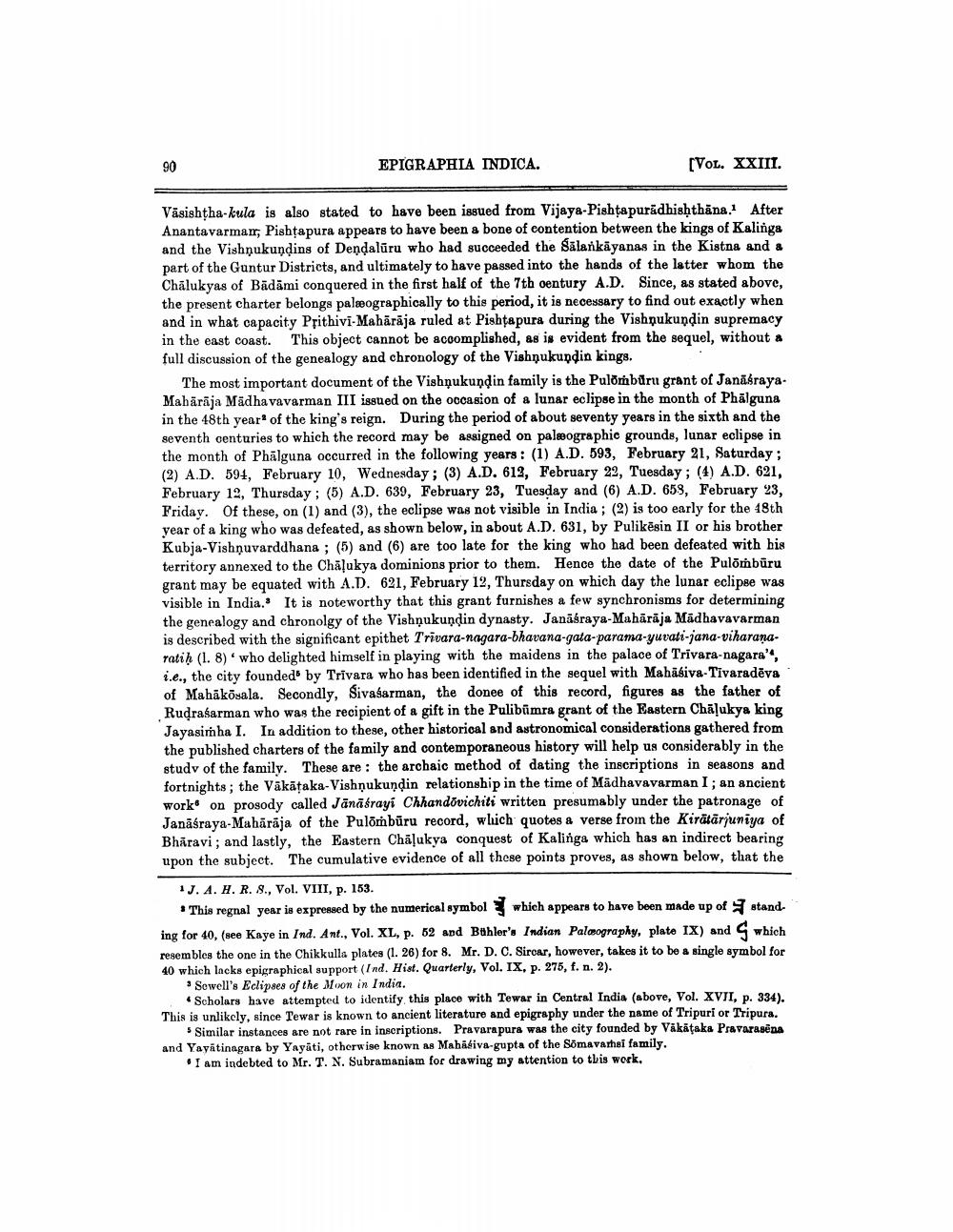________________
90
EPIGRAPHIA INDICA.
[VOL. XXIII.
Väsishtha-kula is also stated to have been issued from Vijaya-Pishtapurădhishthāna. After Anantavarmar, Pishtapura appears to have been a bone of contention between the kings of Kalinga and the Vishnukundins of Dendalūru who had succeeded the Sālankāyanas in the Kistna and a part of the Guntur Districts, and ultimately to have passed into the hands of the latter whom the Chalukyas of Bädämi conquered in the first half of the 7th oentury A.D. Since, as stated above, the present charter belongs palæographically to this period, it is necessary to find out exactly when and in what capacity Prithivi-Mahārāja ruled at Pishtapura during the Vishnukundin supremacy in the east coast. This object cannot be acoomplished, as is evident from the sequel, without a full discussion of the genealogy and chronology of the Vishnukundin kings.
The most important document of the Vishņukundin family is the Pulomburu grant of JanaśrayaMaharaja Madhavavarman III issued on the occasion of a lunar eclipse in the month of Phälguna in the 48th year of the king's reign. During the period of about seventy years in the sixth and the seventh centuries to which the record may be assigned on palæographic grounds, lunar eclipse in the month of Phālguna occurred in the following years: (1) A.D. 593, February 21, Saturday; (2) A.D. 594, February 10, Wednesday; (3) A.D. 612, February 22, Tuesday; (4) A.D. 621, February 12, Thursday: (5) A.D. 639, February 23, Tuesday and (6) A.D. 659, February 23, Friday. Of these, on (1) and (3), the eclipse was not visible in India ; (2) is too early for the 18th year of a king who was defeated, as shown below, in about A.D. 631, by Pulikēsin II or his brother Kubja-Vishnuvarddhana ; (5) and (6) are too late for the king who had been defeated with his territory annexed to the Chāļukya dominions prior to them. Hence the date of the Pulombūru grant may be equated with A.D. 621, February 12, Thursday on which day the lunar eclipse was visible in India. It is noteworthy that this grant furnishes a few synchronisms for determining the genealogy and chronolgy of the Vishnukundin dynasty. Janäsraya-Mahārāja Madhavavarman is described with the significant epithet Trīvara-nagara-bhavana-gata-parama-yuvati-jana-viharanaratih (1. 8)' who delighted himself in playing with the maidens in the palace of Trivara-nagara', i.e., the city founded by Trivara who has been identified in the sequel with Mahäsiva-Tivaradēva of Mahäkösala. Secondly, Sivasarman, the donee of this record, figures as the father of Rudraśarman who was the recipient of a gift in the Pulibūmra grant of the Eastern Chāļukya king Jayasimha I. In addition to these, other historical and astronomical considerations gathered from the published charters of the family and contemporaneous history will help us considerably in the study of the family. These are : the archaic method of dating the inscriptions in seasons and fortnights; the Vākāțaka-Vishņukundin relationship in the time of Madhavavarman I ; an ancient work on prosody called Jānāśrayi Chhandovichiti written presumably under the patronage of Janäsraya-Mahāraja of the Pulombūru record, which quotes a verse from the Kirätārjuniya of Bhāravi; and lastly, the Eastern Chāļukya conquest of Kalinga which has an indirect bearing upon the subject. The cumulative evidence of all these points proves, as shown below, that the
1 J. A. H. R. 8., Vol. VIII, p. 153.
* This regnal year is expressed by the numerical symbol which appears to have been made up of standing for 40, (see Kaye in Ind. Ant., Vol. XL, p. 52 and Bühler's Indian Paleography, plate IX) and which resembles the one in the Chikkulla plates (1. 26) for 8. Mr. D. C. Siroar, however, takes it to be a single symbol for 40 which lacks epigraphical support (Ind. Hist. Quarterly, Vol. IX, p. 275, f. n. 2).
Sewell's Eclipses of the Moon in India.
Scholars have attempted to identify this place with Tewar in Central India (above, Vol. XVII, p. 334). This is unlikely, since Tewar is known to ancient literature and epigraphy under the name of Tripuri or Tripura.
Similar instances are not rare in inscriptions. Pravarapura was the city founded by Vikataka Pravarasena and Yayātinagara by Yayati, otherwise known as Mahādiva-gupta of the Somavahsi family.
.I am indebted to Mr. T. N. Subramaniam for drawing my attention to this work.




